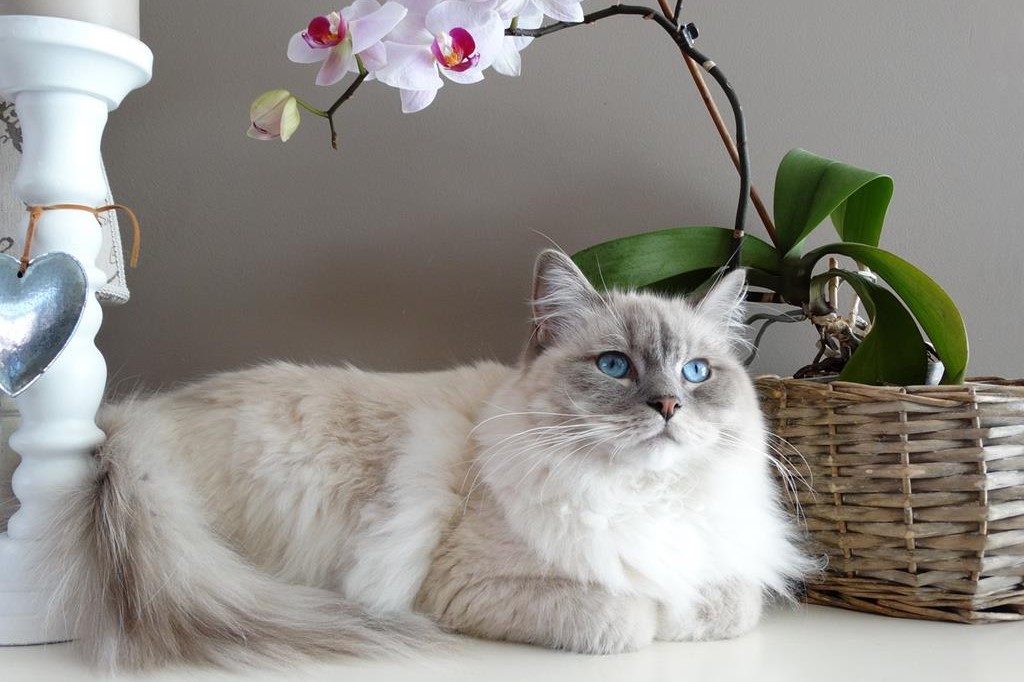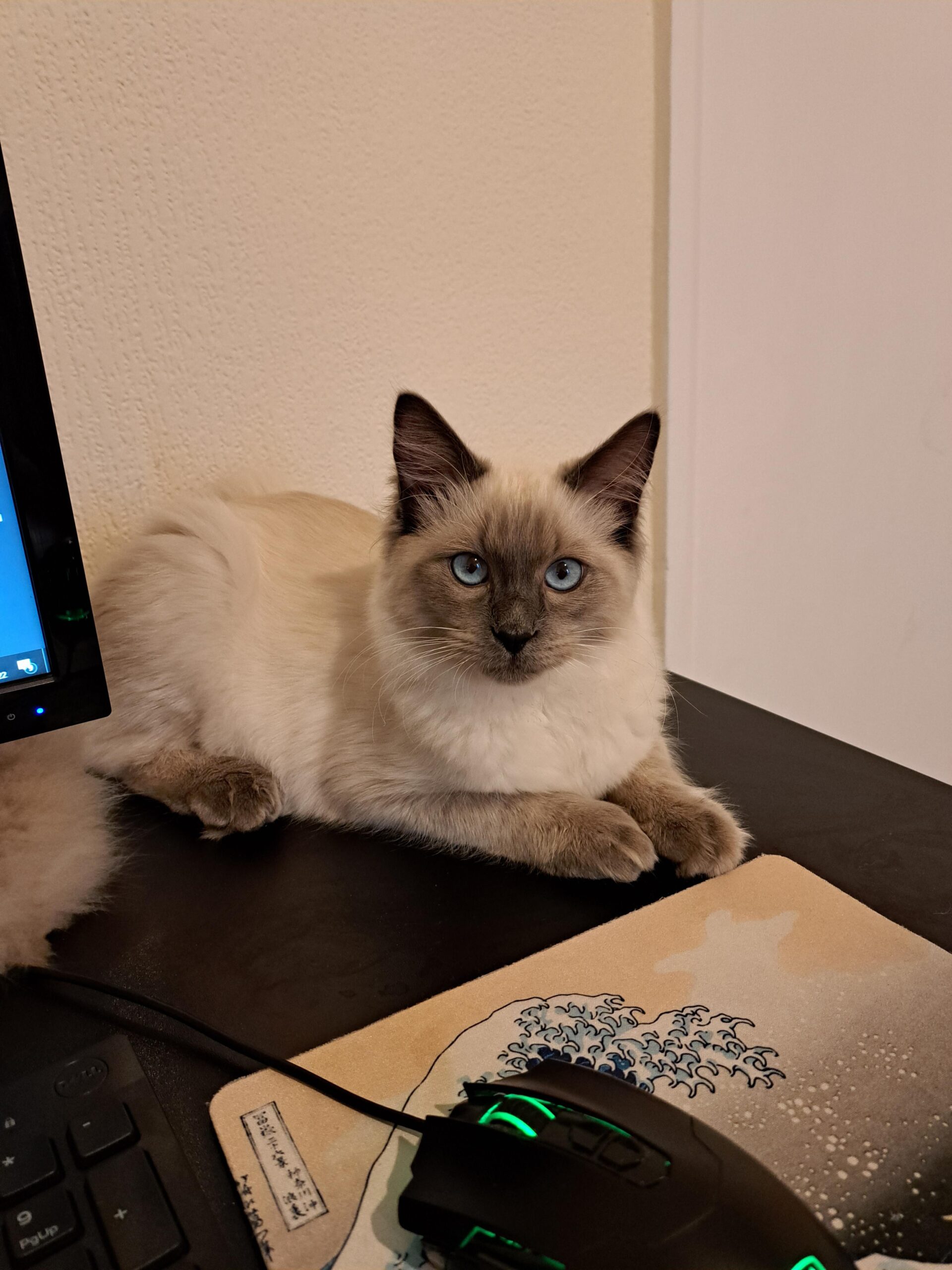A Ragdoll cat’s tail may not be fluffy due to genetic factors, aging, grooming issues, health concerns, or environmental stress. Regular grooming, attention to health, and a stress-free environment can contribute to a fluffier tail.

Ragdoll cats are known for their stunning appearance, including their striking blue eyes and luxurious, semi-long fur that drapes elegantly over their bodies. However, it’s not uncommon for Ragdoll cat owners to notice that their cat’s tail isn’t as fluffy as the rest of their coat. In this article, we’ll explore the potential reasons why your Ragdoll’s tail may not be as fluffy as you’d expect and what you can do to help maintain its beauty.
-
Genetics
One of the primary factors that influence a Ragdoll cat’s appearance, including the fluffiness of their tail, is genetics. Each Ragdoll cat is unique, and the specific traits they inherit from their parents can vary. Some Ragdolls may have naturally less fluffy tails due to their genetic makeup. While breed standards generally call for a plume-like, bushy tail in Ragdolls, individual variations are possible.
-
Age and Growth Stage
The fluffiness of a Ragdoll cat’s tail may change as they age and go through different growth stages. Ragdoll kittens often have thinner and less fluffy tails than adult Ragdolls. As they mature, their fur may become denser and fluffier, including their tail. It’s essential to be patient and allow your Ragdoll kitten to grow into its full coat potential.
-
Grooming
Proper grooming plays a crucial role in maintaining the fluffiness of your Ragdoll’s tail. Neglecting grooming can lead to matting and a less fluffy appearance. Ragdolls are known for their semi-long fur, which requires regular brushing to prevent tangles and mats. If you’re not already doing so, start a grooming routine that includes brushing your cat’s tail. Use a soft-bristle brush or a slicker brush to gently remove loose hair and prevent matting.
-
Seasonal Changes
Like other long-haired cat breeds, Ragdolls may experience seasonal shedding. During shedding seasons, your cat’s tail may appear less fluffy as they naturally shed their old fur to make way for new growth. Regular brushing during these periods can help manage shedding and maintain a fluffier tail.
-
Health Considerations
If you notice a sudden and significant change in the appearance of your Ragdoll’s tail, such as thinning or hair loss, it could be a sign of an underlying health issue. Skin conditions, allergies, or parasites can affect the quality of a cat’s fur, including their tail. If you’re concerned about your cat’s tail or overall coat condition, consult your veterinarian for a thorough examination and appropriate treatment.
Do all Ragdoll cats have fluffy tails?
Yes, typically, Ragdoll cats are known for having fluffy tails. The Ragdoll breed is characterized by semi-longhair fur that is soft, silky, and flows over their body, including their tails. The tail of a Ragdoll cat is often plumed and bushy, contributing to the breed’s overall majestic appearance.
However, individual variations can occur within the breed, and some Ragdolls may have tails with slightly different textures or lengths. While the breed standard emphasizes a silky, semi-longhaired coat, the degree of fluffiness in the tail may vary among individual cats. It’s always a good idea to check with reputable breeders or observe the specific characteristics of the Ragdoll cat in question to get a better understanding of its tail type.
Advance Tips To make Ragdoll tail Fluffy?
Maintaining the fluffiness of your Ragdoll cat’s tail involves a combination of proper grooming and general care. Here are some tips to help ensure your Ragdoll’s tail stays fluffy and in optimal condition:
- Regular Brushing: Brush your Ragdoll’s tail regularly to remove loose fur and prevent matting. Use a soft brush or a comb suitable for long-haired cats.
- Proper Nutrition: Ensure your cat receives a balanced diet rich in nutrients, as this can contribute to a healthy coat, including the tail.
- Hydration: Make sure your Ragdoll stays well-hydrated, as proper hydration supports overall coat health, including the tail.
- Supplements: Consult your veterinarian about adding omega-3 fatty acid supplements to your cat’s diet. These can promote a glossy and healthy coat.
- Gentle Shampooing: Periodically bathe your Ragdoll using a cat-friendly shampoo to keep the tail clean and reduce the risk of matting. Be gentle during the washing process.
- Avoid Over-Bathing: While occasional baths are beneficial, over-bathing can strip natural oils from the fur, leading to dryness. Follow a bathing schedule recommended by your veterinarian.
- Stress Reduction: Minimize stress in your Ragdoll’s environment. Stress can contribute to grooming issues, so providing a calm and secure living space can positively impact your cat’s coat condition.
How often should I groom my Ragdoll cat’s tail?
The frequency of grooming your Ragdoll cat’s tail depends on various factors, including the cat’s individual coat type, activity level, and tendency to develop mats. However, as a general guideline, aim to groom your Ragdoll’s tail at least 2-3 times a week. Here’s a breakdown:
- Regular Brushing: Use a soft brush or comb to remove loose fur and prevent matting. Focus on the tail’s length and base.
- Check for Mats: If your Ragdoll is prone to developing mats, check the tail regularly for any tangles or knots. Addressing these promptly can prevent more significant grooming challenges.
- Bathing Schedule: Depending on your cat’s lifestyle, you may need to bathe your Ragdoll occasionally. Tail grooming can be part of the bathing process, but avoid over-bathing to prevent dryness.
- Adjust Based on Coat Condition: Pay attention to your cat’s coat condition. If you notice increased shedding or matting, you may need to groom the tail more frequently.
Remember, individual cats may have different grooming needs, so observe your Ragdoll’s behavior and coat condition to tailor the grooming routine accordingly. If your cat is cooperative, grooming can be a bonding experience, but always be gentle and patient to ensure a positive grooming experience for your Ragdoll. If you’re unsure about the best grooming practices for your cat, consult with your veterinarian for personalized advice.
How can I prevent matting on my Ragdoll cat’s tail?

Preventing matting on your Ragdoll cat’s tail involves regular grooming and proactive care. Here are some tips to help you prevent matting and keep your Ragdoll’s tail in optimal condition:
- Regular Brushing:
- Brush your Ragdoll cat’s tail at least 2 to 3 times a week. Use a slicker brush or a wide-toothed comb designed for long-haired cats to remove loose fur and prevent tangles.
- Focus on the Base of the Tail:
- Pay special attention to the base of the tail where the fur is denser. Brush this area gently to prevent mats from forming.
- Check for Mats and Tangles:
- Regularly inspect your cat’s tail for any signs of mats or tangles. Address them promptly by gently working through the knots with a comb or your fingers.
- Use Detangling Spray:
- Consider using a cat-friendly detangling spray on your Ragdoll’s tail. This can help make the fur more manageable and reduce the risk of matting.
- Start Grooming Early:
- Introduce grooming to your Ragdoll cat at an early age. This helps them become accustomed to the process, making grooming more comfortable for both you and your cat.
- Provide a Balanced Diet:
- Ensure your Ragdoll cat is on a balanced and nutritious diet. Proper nutrition supports overall coat health, reducing the likelihood of dry or coarse fur that can contribute to matting.
- Hydration is Important:
- Ensure your cat stays well-hydrated. A well-hydrated cat is more likely to have healthier skin and coat, which can help prevent matting.
- Professional Grooming Assistance:
- If you find it challenging to manage your Ragdoll’s tail or encounter persistent matting, consider seeking professional grooming assistance. Professional groomers have the expertise and tools to address matting effectively.
- Trimming the Tail Fur:
- If your Ragdoll’s tail is prone to matting, you may consider trimming the fur slightly to reduce the risk of tangles. Consult with a professional groomer or your veterinarian for guidance on proper trimming techniques.
- Regular Vet Check-ups:
- Schedule regular veterinary check-ups to ensure your Ragdoll cat is in good health. Discuss any concerns about the condition of the tail or coat with your veterinarian.
By incorporating these preventive measures into your grooming routine and overall care, you can help minimize matting and maintain the silky and luxurious appearance of your Ragdoll cat’s tail.
FAQ’s about “Ragdoll’s Tail”
-
Do all Ragdoll cats have fluffy tails?
- While Ragdoll cats are known for their semi-longhair coats, individual variations can occur. Generally, Ragdolls have fluffy tails, but the degree of fluffiness may vary among individual cats.
-
Are there specific grooming tools for Ragdoll cat tails?
- Yes, choose grooming tools designed for long-haired cats. Slicker brushes and wide-toothed combs are suitable for keeping the tail fur smooth and preventing matting.
-
Can I use human hair products on my Ragdoll cat’s tail?
- It’s not advisable to use human hair products on your cat. Stick to cat-friendly grooming products and consult your veterinarian for recommendations.
-
What should I do if my Ragdoll cat’s tail becomes matted?
- If you notice mats on your Ragdoll’s tail, work through them gently using a comb. If the mats are severe or difficult to manage, consider seeking professional grooming assistance to avoid causing stress to your cat.
-
Why does my Ragdoll cat sometimes hold its tail upright?
- Ragdoll cats may hold their tails upright as a sign of confidence or contentment. It’s a natural behavior and often observed when they are relaxed and comfortable in their environment.
Conclusion
While Ragdoll cats are renowned for their fluffy and luxurious coats, it’s not uncommon for individual cats to exhibit variations in the fluffiness of their tails. Genetics, age, grooming, seasonal changes, and health factors can all contribute to the appearance of your Ragdoll’s tail.
If you’re concerned about the fluffiness or condition of your Ragdoll’s tail, consult with your veterinarian for guidance on grooming and potential health issues. Remember that, regardless of tail fluffiness, your Ragdoll’s unique beauty and gentle temperament are what make them a beloved member of your family.



